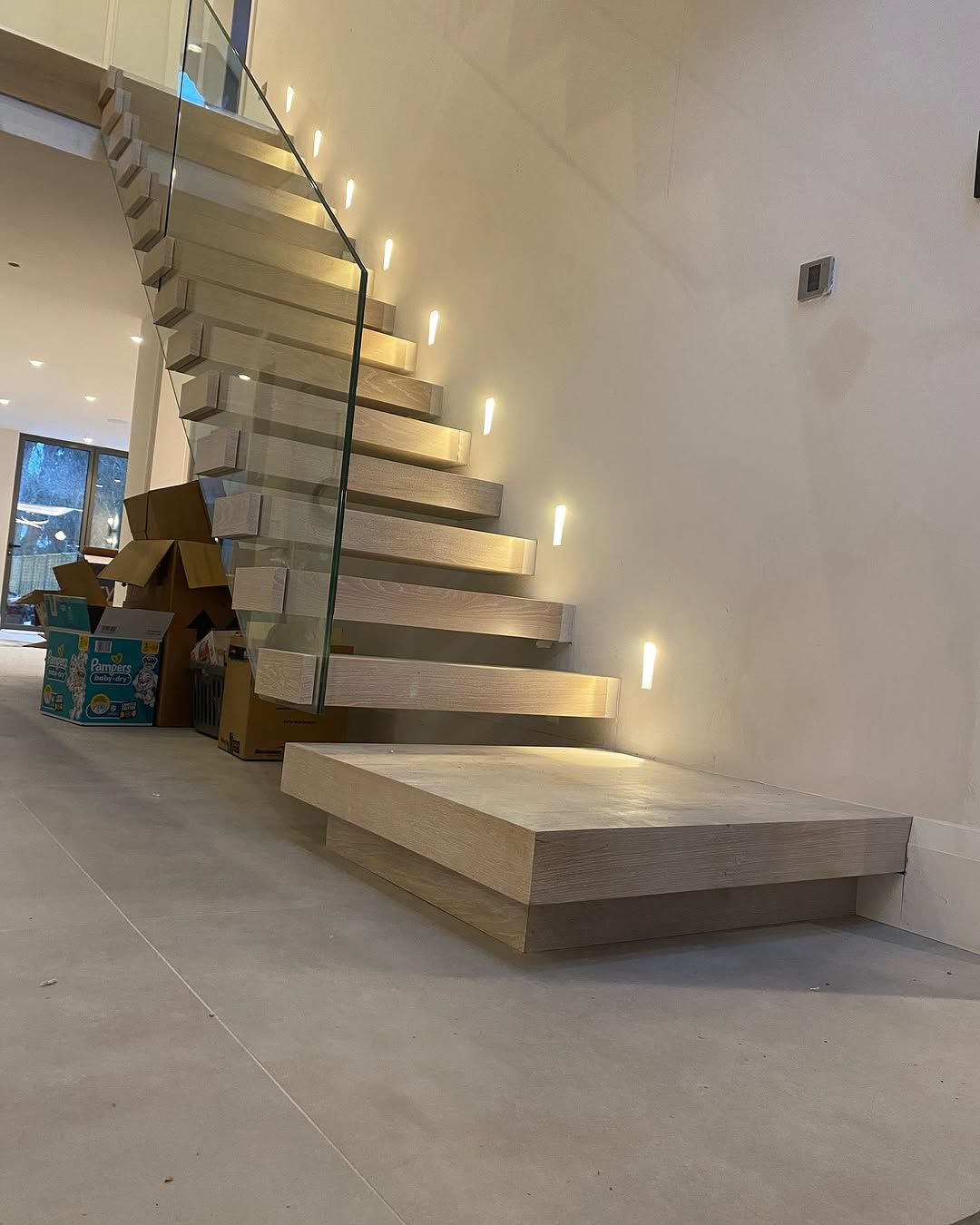
Elevating a simple set of stairs into a feature piece is a great way to bring value and visual interest to your property. Your stairway is not just functional, it’s a key part of your home’s aesthetic.
Refreshing unsafe stairs isn’t just about meeting safety standards—it can also transform the look of your interior entrance.
Knowing the Condition of Your Steps
Think about whether your staircase suits the design and layout of your home before planning an update. If you live in a listed building, you’ll need authorisation from the local council before changing anything. In unprotected houses, it’s important to examine the stairs for any structural issues. Reflect on what you’d like to achieve—can your current staircase cope with the level of renovation you have in mind?
Think about your renovation goals and whether your stairway as it stands can handle them.
Find out if your staircase is suitable for the changes you’re planning.
Be clear on what you want to do and whether your existing staircase are up to the task.
Does your staircase have the stability needed to withstand what you're planning?
Before you begin, consider whether your stairs can support your renovation ideas.
Have a clear idea in mind and check if your staircase can realistically support them.
Plan your renovation with your staircase’s present structure in mind.
Will your current stairway accommodate the design changes you’re considering?
Visualise your design plans—can your current stairs realistically take the upgrade?
Vintage buildings with timber stairs can often be revitalised with DIY efforts, such as swapping out steps or fitting a stylish balustrade.
Older homes with wooden staircases can often be improved through DIY updates like new treads or balustrades.
You can give traditional stairways in vintage houses a fresh look by replacing treads or fitting a new balustrade.
Simple DIY upgrades like swapping out treads or installing an elegant banister can enhance period staircases.
Period-style staircases often look better after basic improvements like tread replacement or balustrade updates.
Many traditional stairways can be enhanced with DIY projects, especially by installing new balustrades or balustrades.
Wooden staircases in older houses often benefit from basic improvements like adding a new handrail.
Replacing worn steps or installing a modern railing can help revive an older staircase.
If you have a timber stairway in a period property, some DIY work may be all it takes to bring it back to life.
Basic updates like changing the steps or fitting a balustrade can revitalise or improve a wooden staircase in a traditional home. For a total revamp, it’s a good idea to speak with an expert early on, comparing the costs and benefits of rebuilding entirely versus upgrading what's there.
If you're planning a complete overhaul, consult a staircase specialist early to compare rebuilding and restoring.
Big changes to your staircase should begin with expert advice to understand costs and possible outcomes.
When considering a full staircase update, a professional can help you choose whether to rebuild or refurbish.
Before starting a full revamp, get a pro's opinion on whether to start fresh or work with the current setup.
A total stairway update should benefit from expert input to balance the pros and cons of each route.
Talking to a staircase professional early can help you decide between starting over or upgrading your current setup.
If a full redesign is on the table, review the cost and design outcomes with help from a staircase expert.
For significant upgrades, it’s sensible to get advice from someone experienced in both refurbishing and rebuilding.
Plan carefully for a complete redesign by speaking with a professional and considering both routes.
Do You Need Permission to Change Your Existing Stairway?
Before you start, find out what building regulations may impact your work. Like-for-like repairs in older buildings often do not require adherence to modern building rules.
However, if modifying the overall layout of the staircase, you must stick to Part K of the Building Regulations, which covers:
If you’re changing the structure of your stairs, you’ll need to comply with Part K of the Building Regulations.
Making major modifications to your staircase design means you must adhere to Part K of the Building Regulations.
Changing the staircase’s layout or shape requires you to meet the standards set in Part K of the regulations.
If your renovation includes structural changes, you’re legally required to comply with Part K standards.
Redesigning the shape or format of your staircase means it must comply with the rules in Part K.
Part K of the Building Regulations applies when you make any significant changes to your staircase layout.
Changing the core format of your stairs will mean adhering to strict rules under Part K.
Big changes to your staircase will need to meet the legal requirements set out in Part K.
You must stick to Part K standards if you’re changing how your staircase is built or shaped.
If your project involves changing the shape or layout of your stairs, Part K regulations will apply.
- Each step must have a horizontal depth of 220mm or more to comply with the building code.
- The upper limit for a stair riser is 220mm under current regulations.
- A approved staircase has nosings projecting no more than the allowed limit, with level treads.
- The headroom above your staircase must be 2m, except for lofts which need only 1.8 metres.
- To meet building rules, open risers must include overlapping treads and limit any gap to under 100mm.
Always seek advice from your council or a qualified expert, as building rules aren’t the same everywhere.
Refreshing a Staircase Without a Full Rebuild
A lot of older stairs suffer from wobbly railings and squeaky steps. Adding a second stringer can help when basic repairs aren't enough. Creaks often result from loosened fixings or aged timber—these can sometimes be fixed, but serious issues may require new parts. Fixing a creaky staircase is possible if the structure or components aren’t too far gone; otherwise, it may need new parts. Bulky newel posts can be made narrower to create extra space, but only if the staircase remains structurally solid.
Updating the Appearance of Your Staircase
You can give your staircase a fresh look using paint, a new runner, or updated stair parts. Under the carpet, you might discover wooden boards that can be reused.
Before starting work on painted check here stairs, carry out a lead test and use safe techniques. If the steps are covered up, it’s important to see the condition of the wood below. Once stripped, the surface can be repainted or covered again, while mouldings may need attention.
How Do You Know It's Time for a New Staircase?
A full replacement may be more affordable in the future if the stairs are in bad condition. A simple staircase swap can be completed in a day, but changing the shape or location is more involved. Because your stairs are part of the building’s framework, it’s important to consult a professional.
Exploring Stair Design Choices
You can choose from multiple options like floating, cantilevered, freestanding, or spiral stairs. Exposed-back stairs can be unsafe for small children, so safer alternatives like solid steps and low risers may be better. A site visit by an expert can guide you in choosing the right staircase for your space. Correct positioning is important when changing your stair layout, and a specialist can help ensure efficiency.
Staircase Costs
Don’t settle for the first price—compare multiple quotes and ask for a breakdown of charges. Even budget-friendly DIY comes with extra considerations—equipment and clean-up.
Ideas for Replacing Stair Railings
If your staircase is narrower than 1m, one handrail is enough—anything broader need a rail both sides. Common materials for balustrades are glass, wood, and metal.
Using toughened glass can increase natural light, but the cost will depend on whether you use visible fixings or a seamless design.
Using Stairs to Add to Your Home’s Look
Consider how your staircase will fit with your interior design—whether you want it to fit in quietly or be a feature. Pair black powder-coated stairs with steel framing for a modern look; use oak handrails with cool tones for something softer.
A handrail aligned with door frames can bring cohesion to your space, with brushed metal spindles adding a stylish contrast.
Stylish and Functional Under-Stair Uses
- Talk to a plumber about installing a space-saving toilet and basin under the stairs for added convenience.
- Use that awkward corner for pull-out storage to keep coats and shoes out of sight.
- Add integrated lighting to create a sleek, eye-catching wine storage area under the stairs.
- Set Up a Compact Office – Install a custom-built desk with shelves, with a neat sliding door finish.
Transform the space into a discreet work zone with smart shelving and desk integration.
Use the area for a small home office—add built-in storage and concealment to keep it neat.
A compact workspace and storage combo under the stairs makes a great hidden office zone.
Fit a bespoke home office under the stairs, complete with sliding doors for a tidy finish.
Create a discreet work zone by installing a desk and storage behind sliding panels.
Add a custom workspace with storage to make a functional under-stair office.
Design a mini office in the space with custom fittings and finish it with neat concealment.
A built-in office nook under the stairs is perfect for remote work.
Use tailored fittings to build an office nook under the stairs with hidden storage.
Turn an empty under-stair area into a compact desk space with a concealed working area. - Use the area creatively as part of your kitchen plan—ideal for a slimline pantry or concealed unit.
Creating Impact with Staircase Lighting
Stair lighting combines function with design, improving both practical use and ambience. Here are some options:
- Lighting built into stair treads.
- Step-level wall lighting make it both practical and stylish.
- Lighting from above provides good visibility and a tidy appearance.
Choose gentle, functional lighting that suits your staircase.
Finale:
A thoughtfully renovated staircase can really elevate your interior. The key to a successful staircase project is choosing what fits your home best—one that looks great and functions well over time.
 Lark Voorhies Then & Now!
Lark Voorhies Then & Now! Marla Sokoloff Then & Now!
Marla Sokoloff Then & Now! Seth Green Then & Now!
Seth Green Then & Now! Soleil Moon Frye Then & Now!
Soleil Moon Frye Then & Now! Melissa Sue Anderson Then & Now!
Melissa Sue Anderson Then & Now!